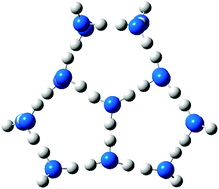Relative energies of water nanoclusters (H2O)20: comparison of empirical and nonempirical double-hybrids with generalized energy-based fragmentation approach
Abstract
Double-hybrid (DH) approximations have proved to be powerful tools for computing various properties through the density functional theory (DFT). In the present work, we analyze the performances of some recently proposed parameterized (empirical) and parameter-free (nonempirical) DH density functionals based on Perdew–Burke–Ernzerhof (PBE) and Becke–Lee–Yang–Parr (BLYP) approximations along with their parent methods for predicting the relative energies of 10 low-energy isomers of water nanoclusters (H2O)20. As a reference to benchmark the performance of functionals, we employ a novel methodology based on generalized energy-based fragmentation (GEBF) approach, in which canonical Hartree–Fock (HF) total energy is combined with the GEBF-CCSD(T) correlation energy, GEBF-CCSD(T)/HF, at the complete basis set limit. It is shown that the PBE-based functionals perform better than the functionals that include BLYP approximation. Of the tested parameterized DHs, B2GP-PLYP performs the best, while among the family of parameter-free models, the PBE-QIDH functional outperforms others. Putting all the results together, the parameter-free adiabatic connection-based functional PBE-QIDH is found to be superior for overall performance. Dissecting the role of both exact exchange and second-order Møller–Plesset perturbation theory (MP2) correlation on the relative energies of water 20-mers, we find that a particular compromise between the two weights is needed to reach a reasonable accuracy. However, it turns out that it is difficult to use the DH approximations to predict the correct relative order of stabilities for the considered water nanoclusters. On the whole, this study points out that if the computational cost is not a serious bottleneck for DH density functional computations on large nanostructures and nanomaterials, older approximations can be superseded by new DHs with the aim of reaching the increased accuracy.


 Please wait while we load your content...
Please wait while we load your content...